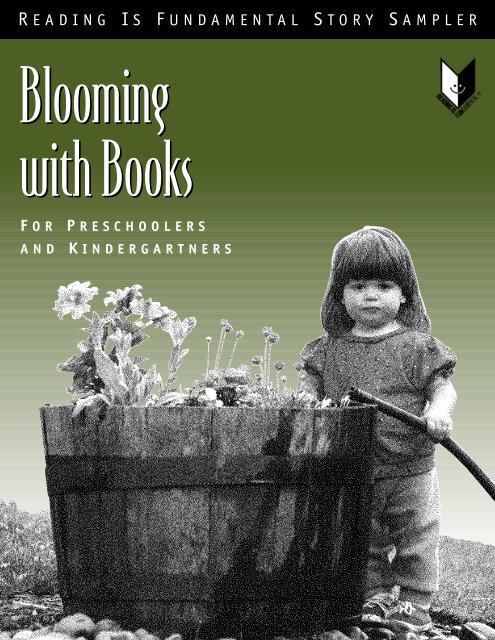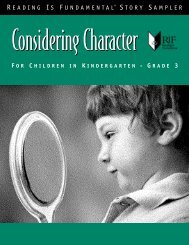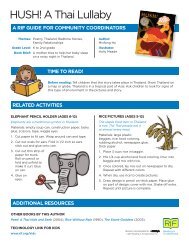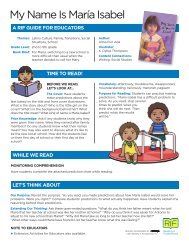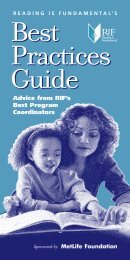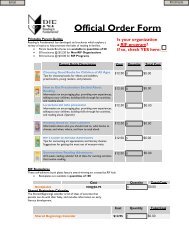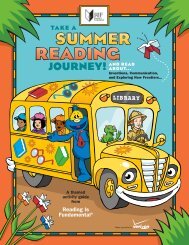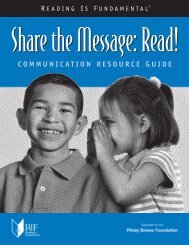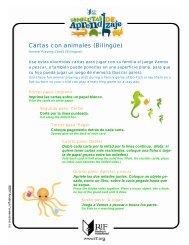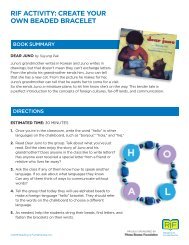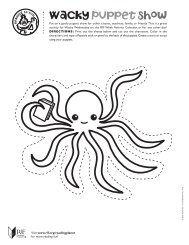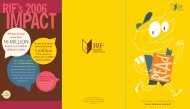Gardening Story Sampler - Reading Is Fundamental
Gardening Story Sampler - Reading Is Fundamental
Gardening Story Sampler - Reading Is Fundamental
Create successful ePaper yourself
Turn your PDF publications into a flip-book with our unique Google optimized e-Paper software.
R EADING I S F UNDAMENTAL S T ORY S AMPLER<br />
Blooming<br />
with Books<br />
F OR<br />
AND<br />
P RESCHOOLERS<br />
K INDERGARTNERS
Support for <strong>Reading</strong> <strong>Is</strong> <strong>Fundamental</strong>, Inc.<br />
comes from corporations, foundations,<br />
government, and other national service<br />
organizations. RIF is affiliated with the<br />
Smithsonian Institution and has been<br />
accorded tax-exempt status under Section<br />
501 (c)(3) of the Internal Revenue Code.<br />
Contributions to RIF are tax-deductible to<br />
the fullest extent of the law.<br />
<strong>Reading</strong> <strong>Is</strong> <strong>Fundamental</strong>, RIF, and the logo<br />
design showing the open book with a<br />
smiling face on it and the words <strong>Reading</strong> <strong>Is</strong><br />
<strong>Fundamental</strong> underneath it are all registered<br />
service marks of <strong>Reading</strong> <strong>Is</strong> <strong>Fundamental</strong>,<br />
Inc. All rights reserved.<br />
Created and developed by Sara Horwitz,<br />
<strong>Reading</strong> <strong>Is</strong> <strong>Fundamental</strong>, Inc.<br />
and Kathy Broderick, Consultant<br />
<strong>Reading</strong> <strong>Is</strong> <strong>Fundamental</strong>, Inc.<br />
1825 Connecticut Avenue, N. W.<br />
Suite 400<br />
Washington, D.C. 20009-5726<br />
Toll free: 877-743-7323<br />
Web site: www.rif.org<br />
© 2001 <strong>Reading</strong> <strong>Is</strong> <strong>Fundamental</strong>, Inc.<br />
All rights reserved.
Introduction<br />
What <strong>Is</strong> a<br />
<strong>Story</strong> <strong>Sampler</strong>?<br />
A <strong>Story</strong> <strong>Sampler</strong> makes books come<br />
alive for children. It is a book-based<br />
thematic approach to reading designed<br />
to engage children in the book<br />
experience. Each <strong>Story</strong> <strong>Sampler</strong><br />
includes hands-on, cross-curricular<br />
activities for books that are linked by<br />
a common theme.<br />
Why Use a <strong>Story</strong> <strong>Sampler</strong>?<br />
Motivational activities are an important part of every<br />
<strong>Reading</strong> <strong>Is</strong> <strong>Fundamental</strong> program. And these motivational<br />
activities are an easy way to excite children’s interest in<br />
reading and help them associate books and reading with<br />
positive experiences and that means fun! The ideas you will<br />
find in each <strong>Story</strong> <strong>Sampler</strong> show you how to build<br />
anticipation and excitement in your RIF programs.<br />
Scores of studies show that students learn more and do<br />
better in school when their parents are involved in their<br />
education. Different types of hands-on activities enable all<br />
children to learn in different ways. Particular questions<br />
before, during and after read aloud activities can develop<br />
high order thinking skills.<br />
Family members can encourage children to become<br />
life-long readers by reading aloud with them everyday.<br />
<strong>Reading</strong> aloud to children is one of the most effective ways<br />
to support language and literacy development. Children<br />
who are read to from infancy associate reading with pleasant,<br />
warm feelings. When you invite children to participate in<br />
reading, ask open-ended questions that promote creative<br />
thinking and learning, and plan activities and experiences<br />
that allow children to expand their understanding of the<br />
story, you help them develop a love of reading.<br />
What Are the Standard Elements<br />
of a <strong>Story</strong> <strong>Sampler</strong>?<br />
Each section of the <strong>Story</strong> <strong>Sampler</strong> includes a featured book<br />
plus additional titles and resources.* The activities that<br />
accompany each section will help you develop a literacy-rich<br />
environment that contributes significantly to a child’s<br />
enjoyment of reading. The standard elements in the <strong>Story</strong><br />
<strong>Sampler</strong> include:<br />
■ Questions to ask<br />
■ Things to do<br />
■ Family involvement<br />
■ Community connections<br />
*The ISBN listed indicates a specific edition of the book.<br />
However, other editions may also be available through the<br />
public library or other publishers.<br />
Who Should Use a <strong>Story</strong> <strong>Sampler</strong><br />
and Where?<br />
Some <strong>Story</strong> <strong>Sampler</strong>s are age-specific, but most can be<br />
adapted to a broad range of ages. Teachers, families, and<br />
child-care providers can use them in classrooms,<br />
community centers, homes, and in Head Start sites. And<br />
most importantly, parents can extend the story beyond the<br />
classroom with home-based projects and field trips.<br />
<strong>Story</strong> <strong>Sampler</strong>s can forge relationships and shared<br />
experiences within the family and the community. Through<br />
the family, children can be introduced to many kinds of<br />
books. Books can explain and reinforce concepts; allow<br />
children to build positive self-images; stimulate discussions<br />
and thinking; increase children’s understanding of<br />
various concepts; and expand their imagination.<br />
The age range for a <strong>Story</strong> <strong>Sampler</strong> is indicated at the<br />
beginning of each set of activities.<br />
1
When and How Should I Use<br />
a <strong>Story</strong> <strong>Sampler</strong>?<br />
<strong>Story</strong> <strong>Sampler</strong>s can be used within or as a supplement to a<br />
curriculum or an after-school program. They can be part of<br />
reading challenges, reading weeks, and family involvement<br />
events. Your imagination and the interests of the children<br />
who participate in the RIF program will help determine the<br />
best way to use the <strong>Story</strong> <strong>Sampler</strong>. Enjoy and have fun!<br />
Tips for <strong>Reading</strong> Aloud<br />
Blooming<br />
with Books<br />
A STORY SAMPLER FOR<br />
PRESCHOOLERS AND<br />
KINDERGARTNERS<br />
Before You Read a <strong>Story</strong>…<br />
■ Make sure everyone is comfortable<br />
■ Show the cover and read the title and author of the book<br />
■ Ask the children about the cover<br />
■ Suggest things the children can look or listen for during<br />
the story<br />
During a <strong>Story</strong>…<br />
■ Change your voice to fit the mood or action<br />
■ Move your finger under the words as you read them<br />
■ Show the pictures and talk about the book as you read<br />
■ Add information or change words to help kids understand<br />
more words and explain the meaning of a new word<br />
■ Ask children to make predictions about the plot, the<br />
characters, and the setting<br />
■ Share your own thoughts about the story<br />
■ Follow the cues of the children<br />
After You Read a <strong>Story</strong>…<br />
■ Ask questions about what happened in the story<br />
■ Encourage the group to relate the story to their own<br />
experiences<br />
■ Ask children how they might feel or act if they were one<br />
of the characters<br />
■ Encourage children to share their thoughts about the<br />
story and pictures<br />
■ Extend the story with an activity or another book<br />
▲<br />
▲ ▲ ▲ ▲<br />
CARING FOR A GARDEN<br />
Growing Vegetable Soup<br />
by Lois Ehlert, Harcourt Brace, 1990<br />
ISBN 0152325808<br />
MAKING THE WORLD<br />
A BETTER PLACE<br />
Miss Rumphius<br />
by Barbara Cooney, Viking, 1985<br />
ISBN 0140505393<br />
GARDEN LORE<br />
The Tale of Peter Rabbit<br />
by Beatrix Potter, Scholastic Trade, 1987<br />
ISBN 0590411012<br />
DELICIOUS DELIGHTS FROM<br />
THE GARDEN<br />
The Ugly Vegetables<br />
by Grace Lin, Charlesbridge Publishing, 1999<br />
ISBN 0881063363<br />
GROWING A TALL TALE<br />
Jamie O’Rourke and the<br />
Big Potato<br />
by Tomie dePaola, Paper Star, 1997<br />
ISBN 0698116038<br />
2
Caring for<br />
a Garden<br />
Growing<br />
Vegetable Soup<br />
by Lois Ehlert<br />
Harcourt Brace, 1990<br />
ISBN 0152325808<br />
Bold artwork identifies various vegetables<br />
and the different stages of a vegetable<br />
garden that a father and child are growing<br />
together. Pictures using bright colors<br />
and simple shapes are easy to see from a<br />
distance, making this book perfect for<br />
reading aloud to a group. Ehlert also<br />
labels everything in her drawings, so that<br />
children will love to study this book on<br />
their own as well.<br />
What To Do Before <strong>Reading</strong> the <strong>Story</strong><br />
■ Choose one of the following musical introductions.<br />
– Play a recording of the famous “Garden Song.” Peter,<br />
Paul, and Mary recorded a version on their album Peter,<br />
Paul and Mommy, Too (Warner Brothers, 1993). Talk<br />
about the meaning of the words.<br />
– There is also Raffi’s album One Light, One Sun that has<br />
a song called “In My Garden.”<br />
– You might also try Woody Guthrie’s Woody’s 20 Grow<br />
Big Songs where there is a song called “Little Seed”<br />
(Source: Children’s Jukebox by Rob Reid).<br />
■ Talk about different kinds of gardens: vegetable gardens, flower<br />
gardens, butterfly gardens, community gardens, herb gardens,<br />
windowsill gardens, etc....Make the point that anyone,<br />
anywhere in the world, can plant a garden and that gardens can<br />
be as small or as big as a person wants them to be.<br />
■ Discuss the fact that all gardens, no matter what type, need<br />
certain things. Let the children talk about what a basic garden<br />
needs (water, sunlight, good soil, room to grow).<br />
3
–Explain what it means to sprout or weed.<br />
–Point out how the characters in this book care for their<br />
garden (they water, weed, and stake up the bigger plants and<br />
climbing plants).<br />
–Point out that on some plants, like the squash in this book, a<br />
flower blooms before the fruit appears.<br />
–Talk about how some things grow underground and need to be<br />
dug up, and other things grow above ground and can be picked.<br />
■ Have children call out different colors and different shapes<br />
they see in the pictures, and see if they can name the various<br />
vegetables.<br />
What You Can Do When You Finish<br />
<strong>Reading</strong> the <strong>Story</strong><br />
■ Ask the children how the bright pictures in this book made<br />
them feel.<br />
■ Discuss how the artist made the pictures with simple cut-out<br />
shapes.<br />
■ Ask the children if they think Lois Ehlert grows a garden<br />
herself, and how a garden must make her feel. Explain what a<br />
dedication is and read the children Ehlert’s dedication in the<br />
front of the book.<br />
Sorting Seeds<br />
Obtain 20 or so seed packets of various kinds, both flowers and<br />
vegetables. For young children, have them sort the packets into<br />
two piles: flowers and vegetables. Or, more than two piles: red<br />
vegetables, green vegetables, pink flowers, white flowers, etc. Let<br />
them count the number of flower packets, vegetable packets, or<br />
even the seeds inside a packet. For children a little older, teach<br />
them the names of the vegetable or flower on the front of the<br />
seed packets.<br />
Charting Growth<br />
What To Talk About<br />
During the <strong>Story</strong><br />
■ Hold up the cover of the book and ask children where they get<br />
their vegetable soup.<br />
–Do they buy vegetable soup in a can from the store?<br />
–How does that soup get in a can? (Make sure to show the<br />
children the recipe on the back cover of the book after reading<br />
the story).<br />
■ Talk about about planting seeds;<br />
–Point out that different vegetables grow from different seeds<br />
(if a bean seed is planted, then a bean plant will grow).<br />
Read the book The Carrot Seed by Ruth Krauss, Harper Trophy,<br />
1989. Talk about how the little boy in the story waited patiently<br />
for the carrot to grow. Ask the kids why people, plants, and<br />
animals take time to grow and review what kinds of things they<br />
need to grow.<br />
Gather some clear plastic cups, seeds that take a short time to<br />
germinate, potting soil, popsicle sticks labeled with each child’s<br />
name, and a long piece of chart paper or growth chart. Plant the<br />
seeds in the soil in the cups, place the popsicle sticks in the cup with<br />
the soil, and seed and tack the growth chart to the wall. Water the<br />
plants when you have snack each day so that the children associate<br />
the nutrition they receive in order to grow with the nutrients the<br />
plants need in order to develop.<br />
Measure each child weekly and have them observe the growth the<br />
seed makes each week. At the end of a few months, take pictures<br />
of each child holding their plant in one hand and a sign that tells<br />
how much they grew together during the allotted time. Develop<br />
the pictures and place them in an album for the children to see<br />
how much they have grown!<br />
4
Thirsty Plants!<br />
A great way to illustrate how plants and flowers need water, air,<br />
and the sun to grow is to get a carnation and a carrot top. Put<br />
the carrot top in a small dish that has some water in it. Put the<br />
carnation in a thin vase and mark with a marker where the water<br />
comes up to in the vase.<br />
After two or three days, check on the carrot and the carnation. A<br />
noticeable amount of growth should have taken place with the<br />
carrot top, and the water in the vase with the carnation should be<br />
below the mark made the previous day. Show the children how<br />
the carnation drank the water and how the top of the carrot grew<br />
with the help of the air, water, and sunlight.<br />
Family Involvement<br />
■ Ask your children to look around your home for objects that<br />
no one wants or needs anymore (an old pot, crate, jar) and<br />
have them try to imagine growing something inside that<br />
container. It can be anything (even an old pair of shoes)! Grab<br />
some seeds and some soil and plant together. For more ideas,<br />
a good book to have around is Growing Things,from the Play<br />
and Learn series with Dib, Dab, and Dob. 1997. DK.<br />
■ Make a copy of the recipe for Vegetable Soup that is at the<br />
back of the book by Lois Ehlert and try cooking it with your<br />
children.<br />
Community Connection<br />
■ Take a nature walk through the community. Whether you live<br />
in an urban, suburban or rural area, see what kinds of<br />
vegetation grow in your environment. Review with the children<br />
what plants need in order to grow. Depending on the season,<br />
point out what is in bloom or what will<br />
eventually change when the weather takes a turn.<br />
■ Go picking at the nearest orchard! Harvesting apples,<br />
pumpkins, strawberries, blueberries, acorns, or anything that<br />
might be in season is usually a fun experience for young<br />
children.<br />
Additional Titles<br />
All of the following books can be used to talk about the feeling of<br />
satisfaction that people get from growing plants from seeds. It’s a<br />
lot of work, but with patience and dedication the gardener is<br />
always rewarded (as in the following examples, with a giant carrot,<br />
a beanstalk, or a basketful of beautiful vegetables).<br />
The Carrot Seed by Ruth Krauss, HarperTrophy, 1989<br />
ISBN 0064432106<br />
Despite the doubts of a little boy’s immediate family, his seed<br />
yields a carrot that surprises them all, just like he knew it would.<br />
Pumpkin Pumpkin by Jeanne Titherington, Mulberry Books, 1990<br />
ISBN: 0688099300<br />
Jamie plants a pumpkin seed in the spring and watches it sprout<br />
and grow all summer until it is perfect in the fall to become a<br />
jack-o-lantern for Halloween. He wisely saves the seeds to replant<br />
again in the spring.<br />
Jasper’s Beanstalk by Nick Butterworth, Simon & Schuster, 1997<br />
ISBN 0689815409<br />
Jasper, a black cat, tries hard—too hard—all week long to get his<br />
bean to grow. When it finally does, Jasper is in for a great surprise.<br />
This book also uses the days of the week effectively.<br />
Vegetable Garden by Douglas Florian, Harcourt Brace, 1996<br />
ISBN 0152010181<br />
Rhyming phrases tell of a family that plants a vegetable garden in<br />
the spring, tends to it throughout the summer, and harvests its<br />
fruits in the fall. This is a good book to use when explaining that<br />
outdoor plants need a lot of sunlight and a certain warm temperature<br />
to grow, which is why in colder climates seeds are planted in<br />
the spring.<br />
First Tomato: A Voyage to the Bunny Planet by Rosemary Wells,<br />
Harcourt Brace, 1992<br />
ISBN: 0803711751<br />
Poor little Claire is not having a good day, but her travels to the<br />
bunny planet where she picks tomatoes and eats sugar snap peas<br />
make her feel much better.<br />
5
Making<br />
the World<br />
a Better Place<br />
Miss<br />
Rumphius<br />
What To Do Before <strong>Reading</strong> the <strong>Story</strong><br />
■ Ask children to think about why people garden: to grow food<br />
to eat, or to sell? Do they like to look at beautiful flowers, or<br />
give them away as a gift?<br />
■ If you are able to get a copy, play the video “The Man Who<br />
Planted Trees,” a beautiful, award-winning animated short film<br />
about a French man who planted acres and acres of forests.<br />
What To Talk About During the <strong>Story</strong><br />
■ Stop at the title page and point out that the flowers there are<br />
called lupines.<br />
■ Miss Rumphius visits the conservatory one winter day. Explain<br />
to the children what a conservatory is and how it works. How<br />
does it make her feel?<br />
■ When Miss Rumphius feels very tired and sick, ask the children<br />
what makes her feel better? Why?<br />
■ The following spring, she discovers lupines in a place she didn’t<br />
plant seeds, discuss with children how the seeds got there<br />
(wind or birds, possibly).<br />
by Barbara Cooney<br />
Viking, 1985<br />
ISBN 0140505393<br />
As a young girl becomes a young lady<br />
and then an older woman, she thinks<br />
about fulfilling the promises she made<br />
to her grandfather and making the<br />
world more beautiful. Cooney’s gentle<br />
illustrations depict the “Lupine Lady,”<br />
a woman who lives a long, rich life, and<br />
who understands the healing power of<br />
flowers.<br />
*A paperback edition is also<br />
available in Spanish.<br />
6
What You Can Do When You Finish<br />
<strong>Reading</strong> the <strong>Story</strong><br />
■ Draw a comparison between Miss Rumphius and Johnny<br />
Appleseed (“the man who planted trees”).<br />
■ Have the children talk about the pictures in this book. If<br />
you have read Vegetable Soup, ask the children how the<br />
illustrations are different from Lois Ehlert’s illustrations?<br />
■ Ask the children if they think Barbara Cooney, the author,<br />
grows a garden. Ask them why artists would like to have<br />
gardens.<br />
Lupine Designs<br />
Bring in a real lupine plant or a seed packet. Have children create<br />
their own lupines, either by gluing beads onto paper, or gluing<br />
scraps of colored paper onto construction paper (mosaic-like).<br />
Use green pipe cleaners for stems and color in leaves with bright<br />
green markers.<br />
Plant an Imagination!<br />
Pretend to be gardeners! Gather gardening gloves, hats or visors,<br />
real or plastic tools, watering cans, and seed packets and use the<br />
dramatic play area or the sandbox. Encourage young children<br />
to dig deep!<br />
Family Involvement<br />
■ Read the story by Eve Bunting called Flower Garden.Talk<br />
about the surprise that the little girl and the father in the<br />
story make for the girl’s mother. Try planting your own<br />
family flower box and help your child care for the new<br />
addition to your home.<br />
■ Find out if there is a community garden in your area and<br />
go for a visit. See if they offer garden tours or have an<br />
information center where you and your child can learn more<br />
about the natural beauty that your environment has to offer.<br />
Community Connection<br />
■ Ask the children if they know of a school or community garden<br />
in their area. Visit it together, or suggest they visit it with their<br />
families. Take a garden walk or garden tour. Or, visit a<br />
conservatory (even in winter!). These are places that make our<br />
communities more beautiful.<br />
■ All fifty states in the U.S. have master gardeners, volunteers who<br />
spread their knowledge of gardening to others who want to<br />
know more about it. Contact a university’s extension services<br />
office to find out how to invite a master gardener to talk to your<br />
children. These are people, like the fictional Miss Rumphius,<br />
who are working to make our communities healthier, more<br />
beautiful places.<br />
Additional Titles<br />
The following books all demonstrate how gardening brightens<br />
our world, on an individual scale or on a grander scale. These<br />
books feature people who have an idea and a way of bringing<br />
pleasure to others through growing plants.<br />
A Field of Sunflowers by Neil Johnson, Scholastic, 1997<br />
ISBN 0590965492<br />
This story of a farmer who decides to plant a crop of sunflowers is<br />
illustrated with full-color photographs. But this is a special farmer,<br />
who lets visitors picnic under the bright yellow blooms, and then,<br />
instead of harvesting the sunflowers, lets the seeds sit, so that<br />
hundreds of birds will come to feed on them.<br />
Flower Garden by Eve Bunting, Harcourt Brace, 2000<br />
ISBN 0152023720<br />
This is a touching story of a young girl and her father who purchase<br />
everything to make a windowsill garden for Mom on her birthday.<br />
The new, bright flowers bring a smile to a mother’s face and color<br />
to the urban setting of this story.<br />
The Gardener by Sarah Stewart, Farrar, 2000<br />
ISBN 0374425183<br />
The impact one individual can make is celebrated in this<br />
Caldecott Honor Book. A young Lydia Grace Finch spends one<br />
growing season with her sour Uncle Jim, spreading love and<br />
inspiration and brightening his world. The story is told in letters<br />
that Lydia writes to Mama, Papa, and Grandma.<br />
A Gardener’s Alphabet by Mary Azarian, Houghton Mifflin Co<br />
(Juv), 2000<br />
ISBN: 0618033807<br />
Each page in this book begins with a letter of the alphabet and<br />
reveals a colorful display of something having to do with<br />
gardening. Young children will like the illustrations, but may need<br />
some help with a few of the words such as compost, topiary, or<br />
xeriscape.<br />
My First Garden by Tomasz Bogacki, Frances Foster Books, 2000<br />
ISBN 0374325189<br />
While riding on a train, a man remembers his childhood and the<br />
garden he made in the cobblestone courtyard by his house. His<br />
daydreaming takes him back in time, and he remembers the<br />
pleasure the garden brought him and all his neighbors.<br />
The Tiny Seed by Eric Carle, Little Simon, 1998<br />
ISBN: 0689819668<br />
The wonderfully colorful illustrations of Eric Carle help tell the<br />
story of the life cycle of a flower as it grows from a seed.<br />
Rabbit Seeds by Bijou Le Tord, Yearling Books, 1993<br />
ISBN 0440407672<br />
<strong>Gardening</strong> can be fun, but it also takes some work. Follow the<br />
gardener as he digs, rakes, waters, and tills through the seasons.<br />
This Year’s Garden by Cynthia Rylant, Aladdin Paperbacks, 1987<br />
ISBN 0689711220<br />
This is another wonderful story that follows the seasons of the year<br />
through a family’s garden and all that they do to care for it.<br />
7
Garden Lore<br />
The Tale of<br />
Peter Rabbit<br />
by Beatrix Potter<br />
Scholastic Trade, 1987<br />
ISBN 0590411012<br />
This is one of the most famous children’s<br />
stories of all time, in which a mischievous<br />
rabbit is chased around Mr. MacGregor’s<br />
garden and narrowly escapes.<br />
What To Do Before <strong>Reading</strong> the <strong>Story</strong><br />
■ Ask the children if they know the story of Peter Rabbit. Or if<br />
they’ve ever heard of Flopsy, Mopsy, and Cottontail.<br />
■ Tell the children that this book was written almost one<br />
hundred years ago by a woman who lived in England. Point<br />
out England on a globe or a map of the world. Ask the<br />
children to listen to how the words in this book sound<br />
different than what we usually read today.<br />
■ Because Beatrix Potter’s watercolors are so detailed and small,<br />
it’s best to read this book to small groups of children, who can<br />
sit closer to the illustrations.<br />
What To Talk About During the <strong>Story</strong><br />
■ If you feel comfortable doing so, read the book with a British<br />
accent. Explain words or phrases that might not be clear to the<br />
children and ask some of the following questions:<br />
–Why does Peter have to squeeze under a gate to get into<br />
Mr. MacGregor’s garden?<br />
– Why does Mr. MacGregor call Peter a thief?<br />
– Even though we’re rooting for Peter, in reality, rabbits are<br />
pests for a gardener. Beatrix Potter took an annoying<br />
problem and turned it into a grand adventure.<br />
■ Have the children talk about how realistic the art looks. Beatrix<br />
Potter must have been a person who knew what gardens looked<br />
like and what animals that visit a garden looked like. Let children<br />
point out the other animals in Mr. MacGregor’s garden.
What You Can Do When You Finish<br />
<strong>Reading</strong> the <strong>Story</strong><br />
■ Talk about how Beatrix Potter is a national figure in England<br />
and that her home and properties are visited by tourists<br />
every year.<br />
■ Let the children know that Beatrix Potter wrote many little<br />
books just like Peter Rabbit, creating a whole imaginary world<br />
of animal characters, and that she really had a pet rabbit!<br />
Video Version<br />
Play the excellent video of The Tale of Peter Rabbit,produced by<br />
the BBC (British Broadcasting Corporation).<br />
Making Up a <strong>Story</strong> Beatrix Potter Style!<br />
Let the children, as a group, invent their own story about an<br />
animal, in the Beatrix Potter style. Let them name the animal and<br />
draw pictures of how it dresses and where it lives. If necessary, an<br />
adult can write the story across the bottom of the pictures. The<br />
pictures can be hung across a wall or bound into a book (with<br />
staples or brass tacks.)<br />
Family Involvement<br />
■ The Bunny Hop is an all time favorite. Show your kids how<br />
to do the simple dance and go hopping down the bunny trail!<br />
■ Follow in the footsteps of Peter Rabbit and enjoy a healthy<br />
snack of carrots together.<br />
■ Watch the BBC’s version of The Tale of Peter Rabbit together.<br />
Community Connection<br />
■ Visit the local library and check out some of the titles from this<br />
section. Grab a blanket, some fruits, and some vegetables and<br />
read one of the old favorites while sitting in a garden or on a<br />
nice patch of grass!<br />
■ Find a local pet store or petting zoo and see if you can find<br />
Peter Rabbit and his friends Flopsy, Mopsy, and Cottontail.<br />
Let the children feed, pet or hold the rabbits and talk about<br />
how the characters in Beatrix Potter’s famous story got<br />
their names.<br />
Additional Titles<br />
The following books are stories that have been around for a<br />
long time and that children may already be familiar with. Like<br />
The Tale of Peter Rabbit, they are not really books about<br />
gardening, but rather famous, high quality stories that are set<br />
in or near a garden.<br />
“The Garden” from Frog and Toad Together by Arnold Lobel,<br />
HarperTrophy, 1979<br />
ISBN 0064440214<br />
This famous and popular best friend team has many adventures.<br />
Frog and Toad teach each other many things. In this story (one of<br />
five in the book), Toad learns that the hard work of gardening is<br />
worth the effort.<br />
Rapunzel by Barbara Rogasky, Holiday, 1987<br />
ISBN 0823406520<br />
A young mother stares at her neighbor’s gorgeous garden and<br />
decides she must have some of the delicious looking plants that<br />
grow there. But this is the witch’s garden — best not to raid it!<br />
Tops and Bottoms by Janet Stevens, Harcourt Brace, 1995<br />
ISBN 0940257009<br />
This Caldecott Honor Book, based in the genre of trickster and<br />
Brer Rabbit tales, tells of Hare who repeatedly tricks Bear out of<br />
the best of their crop.<br />
9
Delicious Delights<br />
From the Garden<br />
The Ugly<br />
Vegetables<br />
by Grace Lin<br />
Charlesbridge Publishing, 1999<br />
ISBN 0881063363<br />
When a little girl and her mother plant<br />
their garden, it doesn’t look like everyone<br />
else’s in the neighborhood. The little girl<br />
doesn’t understand why their garden is not<br />
filled with pretty flowers and buzzing<br />
bumblebees. Her mother reassures her that<br />
what is in their garden is better than the<br />
neighbor’s plants. Eventually<br />
the sweet smell of Ugly<br />
Vegetable Soup fills the<br />
air, and the little girl is<br />
delighted with<br />
what has come<br />
from her mother’s<br />
garden.<br />
What To Do Before <strong>Reading</strong> the <strong>Story</strong><br />
■ The title of the story is a fun place to start. Bring in a few<br />
vegetables such as a cucumber, a pepper, a turnip, or perhaps<br />
a head of lettuce from your garden or the local grocery store.<br />
Ask the children what they think of the vegetables that you are<br />
showing them. Do they like the colors? Are they nice to look at<br />
or are they shaped strangely?<br />
■ Read the title of the story to the children after you have looked<br />
at and discussed the vegetables in front of them. Ask the kids if<br />
they can think of any vegetables that they think are pretty or<br />
that make them want to eat them when they look at them. Ask<br />
the children what they think makes a garden seem attractive. <strong>Is</strong><br />
it the colors or the smell? What can make a garden look ugly?<br />
Things To Talk About During the <strong>Story</strong><br />
■ The illustrations are wonderful in this story. Point out all the<br />
details as you read, especially the differences that the little girl<br />
keeps pointing out to her mother throughout the story.<br />
■ Ask the children why the little girl in the story thinks her<br />
mother’s garden is filled with ugly vegetables. Why does this<br />
make her sad?<br />
■ During the story, the mother starts cooking and the little girl<br />
says everyone is trying to eat the smell; what does that mean?<br />
Ask the children if they have ever smelled something so delicious<br />
that they became hungry just from the smell. If you have the<br />
means, bring in something with a strong tempting scent like<br />
buttered popcorn or cinnamon bread to use as an example.<br />
10
■ Towards the end of the story, everyone in the neighborhood<br />
wants to try some of the yummy smelling soup, so they bring<br />
flowers and things from their garden to trade for a taste. Ask the<br />
children if they have ever wanted something from one of their<br />
friends at lunch and offered to trade for it. Briefly discuss the<br />
benefits of trading between friends.<br />
What You Can Do When You Finish<br />
<strong>Reading</strong> the <strong>Story</strong><br />
■ Talk about how the “ugly vegetable” garden was different from<br />
everyone else’s in the neighborhood. Flowers can be pretty, but<br />
vegetables can be good to eat! Ask the children what they like<br />
about the pictures in the book. What colors do they like? What<br />
kinds of vegetables do they like to eat?<br />
■ Ask the children why they think people choose to grow<br />
different things in their gardens. Why did most of the people<br />
grow flowers? Why did the little girl’s mother grow Chinese<br />
vegetables? Talk about farmers. How do they choose what to<br />
plant in their fields or gardens?<br />
■ Make a list with the children of all the things that you can plant<br />
and grow. (flowers, vegetables, trees, grass, bushes, etc.)<br />
Use All Five Senses!<br />
Gardens are meant to be appealing to the eye, but they can also<br />
be pleasing to the other senses. Grab some mushrooms, carrots,<br />
peppers, or broccoli. Wash and slice them up into bite size pieces.<br />
Buy some of the vegetables cooked and have that ready for the<br />
children to try as well. Talk about some things that the children<br />
might eat that have vegetables in them such as pizza, salads, or<br />
soups. Give each child a small plate of vegetables to smell, taste,<br />
and touch. Let them explore, and find out if they like any of the<br />
“ugly vegetables!”<br />
Pretty Planting<br />
Gather a bunch of old seed or flower catalogs or seed packages,<br />
some scissors, and some glue. Have the children help you make<br />
flower or vegetable picture cards by cutting out pictures from the<br />
catalogs. Glue the pictures onto index cards and let them dry.<br />
Take sheets of primary colored construction paper and place<br />
them out in front of the children. Label each colored piece of<br />
construction paper “Red,” “Blue,” “Green,” etc., and let the<br />
children sort the cards by color by placing each card on the<br />
corresponding piece of colored paper. When the children finish,<br />
count how many cards are on each color.<br />
If you have the time, grab some butcher paper, paints, and brushes<br />
and create a garden mural. Glue the picture cards onto the mural<br />
and let the children paint some more flowers, plants and trees to<br />
complete the scene.<br />
Family Involvement<br />
■ Make some Ugly Vegetable Soup! The author of the story<br />
provides the recipe for Ugly Vegetable Soup right at the back of<br />
the book along with the ugly vegetables, a description of each<br />
vegetable, and the Chinese symbol for each one.<br />
■ Gather various gardening tools such as rakes, hoes, watering<br />
cans, or spades either from plastic play sets, or old gardening<br />
tools. Put some soil in a large bin or find a plot of soil to use<br />
outside and let the children dig away.<br />
–After some playtime, take a walk around and look at the<br />
types of plants in your area. Are there big trees, small plants,<br />
or perhaps even stalks of corn?<br />
–Ask the children what kinds of gardening tools they might need<br />
to plant what they see around them. Remind them how the<br />
little girl’s mother in the story uses big shovels to plant her<br />
vegetables while the neighbors use smaller shovels and hoes.<br />
–Check some books out of the library that show pictures of<br />
tractors, plows, and lawn mowers to show the children.<br />
Explain that some gardeners or farmers cover a large piece of<br />
land and need large machines to do all the planting and<br />
watering they have to do.<br />
Community Connection<br />
■ If possible, visit a nursery or invite someone from the nursery<br />
to come in and talk to your group about the plants in their<br />
care. Depending on the resources in your area, you may also<br />
want to visit an orchard or plan a walking trip through your<br />
neighborhood to see what you can find. Children often think<br />
that vegetables and fruit come from supermarkets, rather than<br />
trees or seeds planted in the ground. Giving the children a<br />
chance to make firsthand observations will help their<br />
understanding of the gardening process.<br />
■ Explore the community you live in. What kinds of cultures or<br />
nationalities exist where you live? <strong>Is</strong> there a Chinatown or Little<br />
Italy? Find out what kinds of fruits and vegetables are used by<br />
other cultures in their traditional recipes. Try out a new recipe<br />
or trade with your neighbors like the characters in the story,<br />
The Ugly Vegetables!<br />
Additional Titles<br />
Blueberries for Sal by Robert McClosky, Viking Press, 1976<br />
ISBN 014050169X<br />
This classic Caldecott Honor book has been around for many<br />
years and continues to be a warm and fun story to share with<br />
young children. Just make sure you have some blueberries to taste<br />
when you are done reading!<br />
Eating the Alphabet by Lois Ehlert, Red Wagon, 1996<br />
ISBN 015201036X<br />
Eating the Alphabet is just one of several books that Lois Ehlert<br />
has written about food and gardening. The vibrant colors and<br />
large text will appeal to young children and will make everyone<br />
hungry while they learn their ABCs.<br />
The Children’s Kitchen Garden: A Book of <strong>Gardening</strong>, Cooking,<br />
and Learning by Georgeanne Brennan, Ten Speed Press, 1997<br />
ISBN 0898158737<br />
This is a great resource to use with children that not only provides<br />
recipes but also information on composting and how flowers ‘drink’.<br />
11
Growing a<br />
Tall Tale<br />
Jamie O’Rourke<br />
and the Big Potato<br />
retold by Tomie dePaola<br />
Paper Star, 1997<br />
ISBN 0698116038<br />
The night Jamie O’Rourke caught a<br />
leprechaun, he returned home with a<br />
magic potato seed instead of a pot of<br />
gold. Saints preserve us! That clever<br />
leprechaun had outsmarted the laziest<br />
man in all of Ireland! Or had he?<br />
What To Do Before <strong>Reading</strong> the <strong>Story</strong><br />
■ Bring in a real potato to show the children. Talk about its size,<br />
shape, and color and how potatoes grow under the ground.<br />
■ Read the first page, “A Note About The <strong>Story</strong>,” to the children.<br />
Explain a little bit about folktales and how families in various<br />
cultures have passed on stories through the years. Tomie dePaola,<br />
like many other authors, decided to write down some of the<br />
stories he heard as a child.<br />
■ Ask the children if they know of any family stories that have<br />
been passed down through the generations. If there is time,<br />
have the children, or invite parents, to share their family stories.<br />
What To Talk About During the <strong>Story</strong><br />
■ The story takes place in Ireland. Point out where the country is<br />
on a map. Explain that people in Ireland speak with a slight<br />
accent. If you are feeling bold, read the story with an Irish accent.<br />
■ If the children in your group are not familiar with the word<br />
“lazy,” ask them what they think it means based on the sentence<br />
in the book and then explain what it means.<br />
■ Jamie O’Rourke happens upon a leprechaun on his way to<br />
church. The children in your group may not know what a<br />
leprechaun is and what significance he has to Irish culture.<br />
The brief explanation below comes from this website and might<br />
be of some use: http://www.nando.net/toys/stpaddy/ stpaddy.html<br />
Leprechaun<br />
Irish fairy. Looks like a small, old man (about 2 feet tall), often<br />
dressed like a shoemaker, with a cocked hat and a leather apron.<br />
According to legend, leprechauns are aloof and unfriendly, live<br />
alone, and pass the time making shoes...they also possess a<br />
hidden pot of gold. Treasure hunters can often track down a<br />
leprechaun by the sound of his shoemaker’s hammer. If caught,<br />
he can be forced to reveal the whereabouts of his treasure, but the<br />
captor must keep their eyes on him every second. If the captor’s<br />
eyes leave the leprechaun (and he often tricks them into looking<br />
away), he vanishes and all hopes of finding the treasure are lost.<br />
■ The leprechaun grants Jamie a wish instead of his pot of gold.<br />
Young children often like to make wishes. Ask them what they<br />
would ask for if they were granted one wish.<br />
■ As the potato grows and grows, ask the children to predict<br />
what problems Jamie might run into eventually.<br />
What You Can Do When You Finish<br />
<strong>Reading</strong> the <strong>Story</strong><br />
■ Jamie O’Rouke makes out fine in the end. Ask the children<br />
what they think: <strong>Is</strong> Jamie O’Rourke lucky, or lazy, or both?<br />
■ Ask the children if they believe that a potato could really get<br />
that big. Have they ever seen a vegetable or a plant grow to a<br />
giant size?<br />
12
Potato Heads<br />
Mr. and Mrs. Potato Head have been around for many years.<br />
Grab some potatoes, toothpicks, raisins, marshmallows, and any<br />
other kinds of material that you might want to use to create your<br />
own version of the Potato Heads with the children in your group.<br />
Family Involvement<br />
■ Read one of the titles from the list below and talk about<br />
whether or not the events in the story could actually take place.<br />
What makes the story a tall tale? Snuggle up together and read<br />
one of the stories or another famous folktale.<br />
■ Families often pass on stories from generation to generation. Are<br />
there fictional or non-fictional stories that you can share with<br />
your child? Maybe a tale of adventure from your own childhood<br />
or a famous move from one home to another; give your child a<br />
piece of your own history to pass on. Tell your tale with colorful<br />
details and an enthusiastic voice. Ask your child to tell the story<br />
back to you and see how their version compares to yours.<br />
■ Explain what a folktale or a tall tale is to the children. Talk<br />
about how stories that are passed on through time can<br />
sometimes take on a life of their own. Sometimes they are<br />
simply funny or entertaining stories that depict a particular<br />
culture, and sometimes they have a specific moral or message<br />
woven into the fabric of the story.<br />
“One Potato, Two Potato, Three Potato, Four”<br />
Teach the children in your group the rhyme used to decide<br />
whose turn it is:<br />
One potato, two potato, Three potato, four, Five potato, six<br />
potato, Seven potato, more.<br />
Chant the rhyme by either stacking fists or by sitting in a circle<br />
and tapping heads until you get to the word “more” which<br />
decides whose turn it is or who gets to go first. The rhyme can<br />
also be used to play an elimination game like “Simon Says.”<br />
Play a Game of Telephone<br />
If children are not familiar with the game of Telephone, seat them<br />
in a circle and start off by whispering a message into the first<br />
child’s ear. Ask him or her to pass it on. The last child to receive<br />
the message tries to say it out loud, and, more often than not, the<br />
message has been altered somehow. The children will not only get<br />
a kick out of how the message has been changed as it goes down<br />
the line, but it may also help them to see how a tale can grow!<br />
What Can You Make With Potatoes?<br />
Soup, french fries, potatoes au gratin — whatever your little<br />
“pratie” heart desires. Pick a fun and easy recipe that requires<br />
potatoes. Write out the recipe on a large piece of paper. Use<br />
rebus symbols for items like the potatoes, measuring cups, bowls,<br />
and cooking pots to make it more fun for the young children.<br />
Gather the ingredients and let the kids help you cook a delicious<br />
potato feast!<br />
Community Connection<br />
■ See if your community hosts any gardening contests. The<br />
largest pumpkin or giant zucchini might just be growing in<br />
your hometown. Check out what you can find in your own<br />
backyard!<br />
■ Sometimes, towns or cities play host to a variety of local<br />
legends or folktales. Check out the local library or historical<br />
society to see if they know of any tall tales about the<br />
community where you live.<br />
Additional Titles<br />
Jack and the Beanstalk by Matt Faulkner, Scholastic Trade, 1996<br />
ISBN 0590401645<br />
The classic tale of clever Jack who climbs the beanstalk and outwits<br />
the hungry giant.<br />
Jim and the Beanstalk by Raymond Briggs, Paper Star, 1997<br />
ISBN 0698115775<br />
Jim climbs a large beanstalk and encounters a giant at the top with<br />
several modern day issues that he demands Jim help him to resolve.<br />
The Tale of the Turnip by Brian Alderson, Candlewick Press, 1999<br />
ISBN 0763604941<br />
A local farmer plants turnips in his field and one of them<br />
happens to grow to a very large size. The king of the land is so<br />
impressed by the farmer’s efforts, that he rewards him generously<br />
while a jealous neighbor gets his just reward.<br />
The Mouse and the Potato by Thomas Berger, Anthroposophic<br />
Press, 1990<br />
ISBN 0863151035<br />
Another story of a giant potato that grows and grows and<br />
requires many helping hands to get it out of the ground.<br />
13
RIF’S MISSION<br />
<strong>Reading</strong> <strong>Is</strong> <strong>Fundamental</strong>, Inc. (RIF) develops and delivers<br />
children’s and family literacy programs that help prepare<br />
young children for reading and motivate older children<br />
to read. Through a national network of teachers, parents,<br />
and community volunteers, RIF programs provide books<br />
and other essential literacy resources to children at no<br />
cost to them or their families. RIF’s highest priority is the<br />
nation’s neediest children, from infancy to age 11.<br />
ABOUT RIF<br />
Founded in 1966 in Washington, D.C., RIF is the<br />
nation’s oldest and largest nonprofit children’s literacy<br />
organization, with programs operating nationwide in<br />
16,500 schools, child-care centers, libraries, hospitals,<br />
clinics, migrant worker camps, Head Start and Even Start<br />
programs, homeless shelters, and detention centers.<br />
RIF serves more than 3.5 million children through a<br />
network of more than 240,000 volunteers. Two-thirds of<br />
the children served by RIF have economic or learning<br />
needs that put them at risk of failing to achieve basic<br />
educational goals.<br />
Through a contract with the U.S. Department of<br />
Education, RIF provides federal matching funds to<br />
thousands of school and community-based organizations<br />
that sponsor RIF programs. RIF also receives private<br />
support from hundreds of corporations and foundations,<br />
thousands of local organizations and businesses, and<br />
countless individuals.<br />
RIF distributes about 13 million books a year. By the<br />
end of 2000, RIF will have placed more than 200 million<br />
books in the hands and homes of America’s children.<br />
<strong>Reading</strong> <strong>Is</strong> <strong>Fundamental</strong>, Inc.<br />
1825 Connecticut Avenue, N. W., Suite 400<br />
Washington, D.C. 20009-5726<br />
Toll free: 877-743-7323<br />
Web site: www.rif.org<br />
©2001 <strong>Reading</strong> <strong>Is</strong> <strong>Fundamental</strong>, Inc.<br />
All rights reserved.


